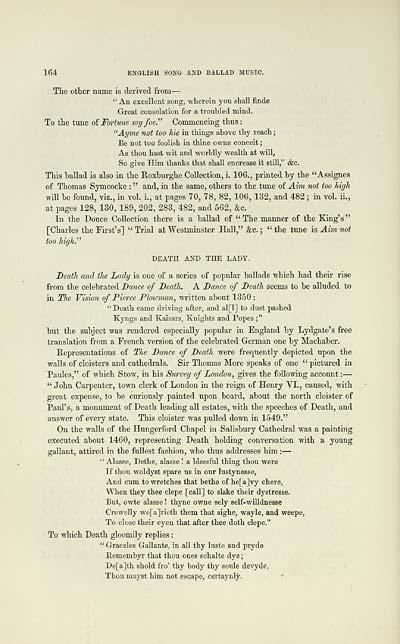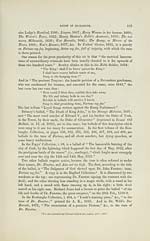Glen Collection of printed music > Printed text > Popular music of the olden time > Volume 1
(198) Page 164 - Death and the lady
Download files
Complete book:
Individual page:
Thumbnail gallery: Grid view | List view

164 ENGLISH SONG AND BALLAD MUSIC.
The other name is derived from —
" An excellent song, wherein you shall finde
Great consolation for a troubled mind.
To the txme oi Fortu7ie my foe." Commencing thus :
"Ayme not too Me in things above thy reach ;
Be not too foolish in thine owne conceit ;
As thou hast wit and worldly wealth at will,
So give Him thanks that shall encreaae it still," &c.
This ballad is also in the Roxburghe Collection, i. 106., printed by the "Assignes
of Thomas Symcocke : " and, in the same, others to the tune of Aim not too high
will be found, viz., in vol. i., at pages 70, 78, 82, 106, 132, and 482 ; ui vol. ii.,
at pages 128, 130, 189, 202, 283, 482, and 562, &c.
In the Douce Collection there is a ballad of "The manner of the King's"
[Charles the First's] " Trial at Westminster Hall," &c. ; " the tune is Aim not
too high.''''
DEATH AND THE LADY.
Death and the Lady is one of a series of popular ballads which had their rise
from the celebrated Dance of Death. A Dance of Death seems to be alluded to
in The Vision of Pierce Plowman, written about 1350 :
" Death came driving after, and al[l] to dust pashed
Kyngs and Kaisars, Knights and Popes ;"
but the subject was rendered especially popular in England by Lydgate's free
translation from a French version of the celebrated German one by Machaber.
Eepresentations of The Dance of Death were frequently depicted upon the
walls of cloisters and cathedrals. Sir Thomas More speaks of one " pictured in
Paules," of which Stow, in his Survey of London, gives the following account : —
" John Carpenter, town clerk of London in the reign of Henry VI., caused, with
great expense, to be curiously painted upon board, about the north cloister of
Paul's, a monument of Death leading all estates, with the speeches of Death, and
answer of every state. This cloister was pulled down in 1549."
On the walls of the Hungerford Chapel in Salisbury Cathedral was a painting
executed about 1460, representing Death holding conversation with a young
gallant, attired in the fullest fashion, who thus addresses him : —
" Alasse, Dethe, alasse ! a hlessful thing thou were
If thou woldyst spare us in our lustynesse.
And cum to wretches that hethe of he[a]vy chere.
When they thee clepe [call] to slake their dystresse.
But, owte alasse 1 thyne owne sely self-willdnesse
Crewelly we[a]rieth them that sighe, wayle, and weepe,
To close their eyen that after thee doth clepe."
To which Death gloomily replies :
" Graceles Gallante, in all thy luste and pryde
Rememhyr that thou ones schalte dye ;
De[a]th shold fro' thy body thy sonle devyde,
Thou mayst him not escape, certaynly.
The other name is derived from —
" An excellent song, wherein you shall finde
Great consolation for a troubled mind.
To the txme oi Fortu7ie my foe." Commencing thus :
"Ayme not too Me in things above thy reach ;
Be not too foolish in thine owne conceit ;
As thou hast wit and worldly wealth at will,
So give Him thanks that shall encreaae it still," &c.
This ballad is also in the Roxburghe Collection, i. 106., printed by the "Assignes
of Thomas Symcocke : " and, in the same, others to the tune of Aim not too high
will be found, viz., in vol. i., at pages 70, 78, 82, 106, 132, and 482 ; ui vol. ii.,
at pages 128, 130, 189, 202, 283, 482, and 562, &c.
In the Douce Collection there is a ballad of "The manner of the King's"
[Charles the First's] " Trial at Westminster Hall," &c. ; " the tune is Aim not
too high.''''
DEATH AND THE LADY.
Death and the Lady is one of a series of popular ballads which had their rise
from the celebrated Dance of Death. A Dance of Death seems to be alluded to
in The Vision of Pierce Plowman, written about 1350 :
" Death came driving after, and al[l] to dust pashed
Kyngs and Kaisars, Knights and Popes ;"
but the subject was rendered especially popular in England by Lydgate's free
translation from a French version of the celebrated German one by Machaber.
Eepresentations of The Dance of Death were frequently depicted upon the
walls of cloisters and cathedrals. Sir Thomas More speaks of one " pictured in
Paules," of which Stow, in his Survey of London, gives the following account : —
" John Carpenter, town clerk of London in the reign of Henry VI., caused, with
great expense, to be curiously painted upon board, about the north cloister of
Paul's, a monument of Death leading all estates, with the speeches of Death, and
answer of every state. This cloister was pulled down in 1549."
On the walls of the Hungerford Chapel in Salisbury Cathedral was a painting
executed about 1460, representing Death holding conversation with a young
gallant, attired in the fullest fashion, who thus addresses him : —
" Alasse, Dethe, alasse ! a hlessful thing thou were
If thou woldyst spare us in our lustynesse.
And cum to wretches that hethe of he[a]vy chere.
When they thee clepe [call] to slake their dystresse.
But, owte alasse 1 thyne owne sely self-willdnesse
Crewelly we[a]rieth them that sighe, wayle, and weepe,
To close their eyen that after thee doth clepe."
To which Death gloomily replies :
" Graceles Gallante, in all thy luste and pryde
Rememhyr that thou ones schalte dye ;
De[a]th shold fro' thy body thy sonle devyde,
Thou mayst him not escape, certaynly.
Set display mode to: Large image | Transcription
Images and transcriptions on this page, including medium image downloads, may be used under the Creative Commons Attribution 4.0 International Licence unless otherwise stated. ![]()
| Special collections of printed music > Glen Collection of printed music > Printed text > Popular music of the olden time > Volume 1 > (198) Page 164 - Death and the lady |
|---|
| Permanent URL | https://digital.nls.uk/91369823 |
|---|
| Shelfmark | Glen.254 |
|---|---|
| Additional NLS resources: | |
| Attribution and copyright: |
|
| Description | Scottish songs and music of the 18th and early 19th centuries, including music for the Highland bagpipe. These are selected items from the collection of John Glen (1833 to 1904). Also includes a few manuscripts, some treatises, and other books on the subject. |
|---|
| Description | The Glen Collection and the Inglis Collection represent mainly 18th and 19th century Scottish music, including Scottish songs. The collections of Berlioz and Verdi collected by bibliographer Cecil Hopkinson contain contemporary and later editions of the works of the two composers Berlioz and Verdi. |
|---|

